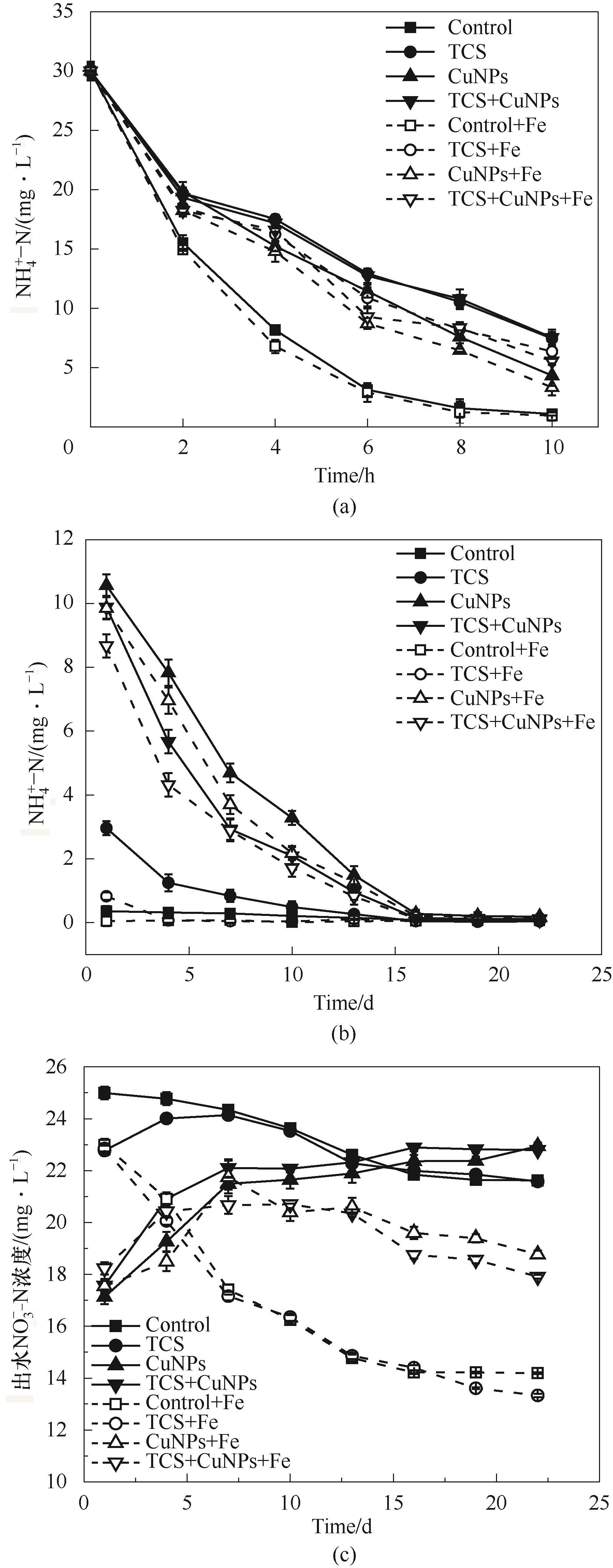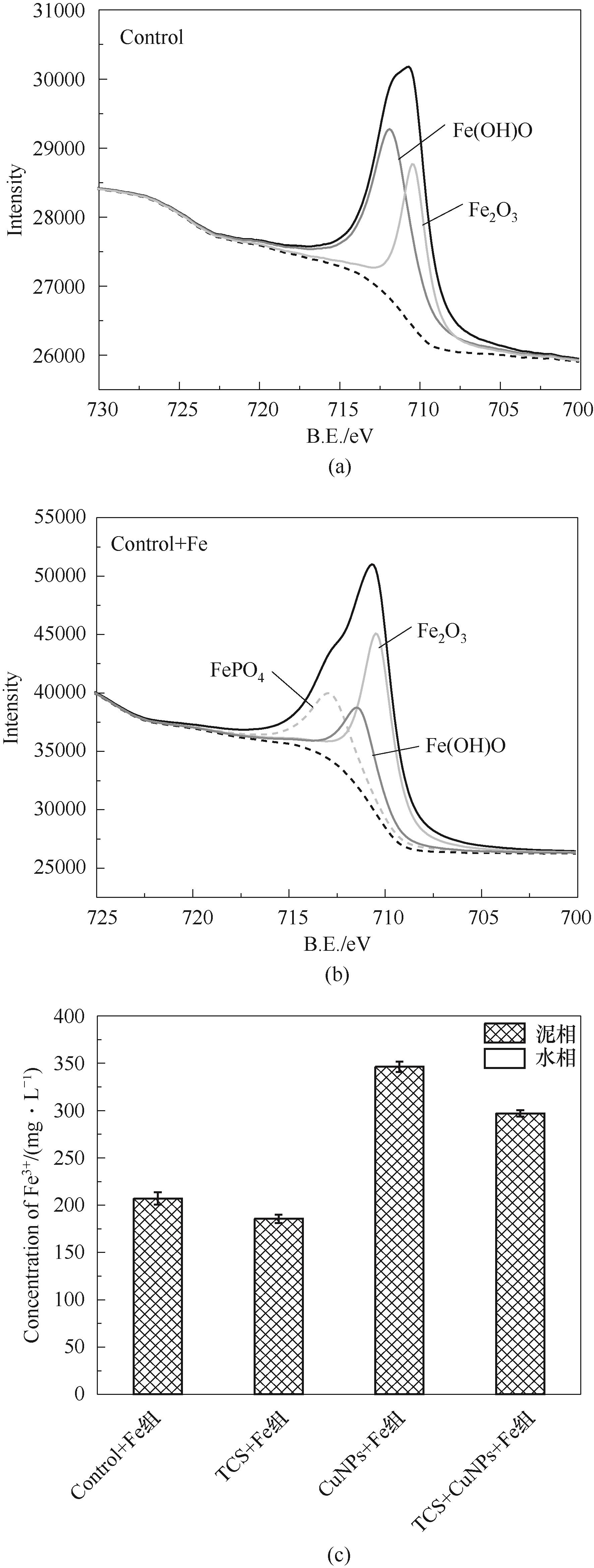CIESC Journal ›› 2021, Vol. 72 ›› Issue (10): 5372-5383.DOI: 10.11949/0438-1157.20210310
• Energy and environmental engineering • Previous Articles Next Articles
Hong CHEN1( ),Jing XIE1,Yuying CHENG1,Xin YU1,Shanping CHEN2,Gang XUE1(
),Jing XIE1,Yuying CHENG1,Xin YU1,Shanping CHEN2,Gang XUE1( ),Meilin WANG1,Yi LUO1,Xiangyu HE1
),Meilin WANG1,Yi LUO1,Xiangyu HE1
Received:2021-03-03
Revised:2021-06-29
Online:2021-10-05
Published:2021-10-05
Contact:
Gang XUE
陈红1( ),谢静1,成钰莹1,于鑫1,陈善平2,薛罡1(
),谢静1,成钰莹1,于鑫1,陈善平2,薛罡1( ),王美琳1,罗意1,贺向宇1
),王美琳1,罗意1,贺向宇1
通讯作者:
薛罡
作者简介:陈红(1986—),女,博士,副教授,基金资助:CLC Number:
Hong CHEN,Jing XIE,Yuying CHENG,Xin YU,Shanping CHEN,Gang XUE,Meilin WANG,Yi LUO,Xiangyu HE. Study on performance and mechanism of enhanced biological nitrification by zero-valent iron[J]. CIESC Journal, 2021, 72(10): 5372-5383.
陈红,谢静,成钰莹,于鑫,陈善平,薛罡,王美琳,罗意,贺向宇. 零价铁强化生物硝化效能及机理研究[J]. 化工学报, 2021, 72(10): 5372-5383.
Add to citation manager EndNote|Ris|BibTeX

Fig.1 The change of ammonia nitrogen concentration with time when short-term exposure (a) and long-term exposure (b) to pollutants and changes of nitrate nitrogen concentration with time under long-term exposure of pollutants (c) (The data in Fig. (b) when long-term exposure without adding iron were quoted from Ref.[4])

Fig.3 XPS spectra of Fe in activated sludge in the Control group (a) and Control+Fe group (b) and the Fe3+ concentration in the four reactors in the Sludge-Fe group (c)
| 1 | Schweizer H P. Triclosan: a widely used biocide and its link to antibiotics[J]. FEMS Microbiology Letters, 2001, 202(1): 1-7. |
| 2 | Zheng X, Yan Z G, Liu P Y, et al. Research progress on toxic effects and water quality criteria of triclosan[J]. Bulletin of Environmental Contamination and Toxicology, 2019, 102(6): 731-740. |
| 3 | 陈芋如. 纳米颗粒物对河口水环境中微生物群落及抗生素抗性基因的影响[D]. 上海: 华东师范大学, 2020. |
| Chen Y R. Impact of nanoparticles on the antibiotic resistance genes(ARGs) in estuarine water: ARG variations and their association with the microbial community[D]. Shanghai: East China Normal University, 2020. | |
| 4 | 成钰莹, 陈红, 薛罡. 纳米铜及三氯生对污泥硝化作用的影响[J]. 环境工程学报, 2018, 12(2): 513-520. |
| Cheng Y Y, Chen H, Xue G. Effect of copper nanoparticles and triclosan on sludge nitrification[J]. Chinese Journal of Environmental Engineering, 2018, 12(2): 513-520. | |
| 5 | Dong X Q, He Y Z, Peng X X, et al. Triclosan in contact with activated sludge and its impact on phosphate removal and microbial community[J]. Bioresource Technology, 2021, 319: 124134. |
| 6 | 周月. 纳米颗粒对自养脱氮工艺的影响研究[D]. 郑州: 郑州轻工业大学, 2019. |
| Zhou Y. Impacts of nano-particles on autotrophic nitrogen removal process[D]. Zhengzhou: Zhengzhou University of Light Industry, 2019. | |
| 7 | Chen H, Cheng Y Y, Meng D, et al. Joint effect of triclosan and copper nanoparticles on wastewater biological nutrient removal[J]. Environmental Technology, 2018, 39(19): 2447-2456. |
| 8 | 孟迪, 陈红, 薛罡. 典型PPCPs与纳米铜颗粒理化性质的交互影响[J]. 化工学报, 2016, 67(10): 4455-4460. |
| Meng D, Chen H, Xue G. Interaction effects of typical PPCPs and copper nanoparticles on physical-chemical properties[J]. CIESC Journal, 2016, 67(10): 4455-4460. | |
| 9 | Liu H B, Chen Z H, Guan Y N, et al. Role and application of iron in water treatment for nitrogen removal: a review[J]. Chemosphere, 2018, 204: 51-62. |
| 10 | Liu Z G, Fan J H, Ma L M, et al. Enhancing simultaneous removal of nitrogen and phosphorus from municipal wastewater by Fe-Cu shavings[J]. Desalination and Water Treatment, 2014, 52(37/38/39): 7422-7428. |
| 11 | Xu Y, Wang C, Hou J, et al. Application of zero valent iron coupling with biological process for wastewater treatment: a review[J]. Reviews in Environmental Science and Bio/Technology, 2017, 16(4): 667-693. |
| 12 | Chen H, Zhao X H, Cheng Y Y, et al. Iron robustly stimulates simultaneous nitrification and denitrification under aerobic conditions[J]. Environmental Science & Technology, 2018, 52(3): 1404-1412. |
| 13 | Chen H, Xue G, Jiang M R, et al. Advanced nitrogen removal from the biological secondary effluent of dyeing wastewater via a biological–ferric–carbon nitrification and denitrification process[J]. RSC Advances, 2016, 6(108): 106951-106959. |
| 14 | 王晓宁. 青枯菌copSRABCD基因簇铜抗性作用机理及表达调控研究[D]. 北京: 中国农业科学院, 2019. |
| Wang X N. Research on the mechanism of copper resistance and expression regulation of copSRABCD gene cluster in Ralstoniasolanacearum[D]. Beijing: Chinese Academy of Agricultural Sciences, 2019. | |
| 15 | Chen H, Liu Y F, Xu X Q, et al. How does iron facilitate the aerated biofilter for tertiary simultaneous nutrient and refractory organics removal from real dyeing wastewater?[J]. Water Research, 2019, 148: 344-358. |
| 16 | Sun W, Qian X, Gu J, et al. Mechanism and effect of temperature on variations in antibiotic resistance genes during anaerobic digestion of dairy manure[J]. Scientific Reports, 2016, 6: 30237. |
| 17 | Lowry O, Rosebrough N, Farr A L, et al. Protein measurement with the folin phenol reagent[J]. Journal of Biological Chemistry, 1951, 193(1): 265-275. |
| 18 | Yuan Y, Zhou Z, Jiang J, et al. Partial nitrification performance and microbial community evolution in the membrane bioreactor for saline stream treatment[J]. Bioresource Technology, 2021, 320: 124419. |
| 19 | Kawagoshi Y, Fujisaki K, Tomoshige Y, et al. Temperature effect on nitrogen removal performance and bacterial community in culture of marine anammox bacteria derived from sea-based waste disposal site[J]. Journal of Bioscience and Bioengineering, 2012, 113(4): 515-520. |
| 20 | Ward N L, Challacombe J F, Janssen P H, et al. Three genomes from the phylum Acidobacteria provide insight into the lifestyles of these microorganisms in soils[J]. Applied and Environmental Microbiology, 2009, 75(7): 2046-2056. |
| 21 | Wang W F, Qiu Z Q, Tan H M, et al. Siderophore production by actinobacteria[J]. BioMetals, 2014, 27(4): 623-631. |
| 22 | McNamara P J, LaPara T M, Novak P J. The impacts of triclosan on anaerobic community structures, function, and antimicrobial resistance[J]. Environmental Science & Technology, 2014, 48(13): 7393-7400. |
| 23 | Lejon D P H, Nowak V, Bouko S, et al. Fingerprinting and diversity of bacterial copA genes in response to soil types, soil organic status and copper contamination[J]. FEMS Microbiology Ecology, 2007, 61(3): 424-437. |
| 24 | Alquethamy S, Khorvash M, Pederick V, et al. The role of the CopA copper efflux system in Acinetobacter baumannii virulence[J]. International Journal of Molecular Sciences, 2019, 20(3): 575. |
| 25 | 杨帆, 徐雯丽, 钱雅洁, 等. 零价铁对污泥厌氧消化过程中四环素抗性基因水平转移的作用影响[J]. 环境科学, 2018, 39(4): 1748-1755. |
| Yang F, Xu W L, Qian Y J, et al. Effect of zero valent iron on the horizontal gene transfer of tetracycline resistance genes during anaerobic sludge digestion process[J]. Environmental Science, 2018, 39(4): 1748-1755. | |
| 26 | Cao Q, Liu X F, Ran Y, et al. Methane oxidation coupled to denitrification under microaerobic and hypoxic conditions in leach bed bioreactors[J]. Science of the Total Environment, 2019, 649: 1-11. |
| 27 | Zhang S H, Pang S, Wang P F, et al. Responses of bacterial community structure and denitrifying bacteria in biofilm to submerged macrophytes and nitrate[J]. Scientific Reports, 2016, 6: 36178. |
| 28 | Daims H, Lebedeva E V, Pjevac P, et al. Complete nitrification by Nitrospira bacteria[J]. Nature, 2015, 528(7583): 504-509. |
| 29 | Wang Z Y, Yao Y N, Steiner N, et al. Impacts of nitrogen-containing coagulants on the nitritation/denitrification of anaerobic digester centrate[J]. Environmental Science: Water Research & Technology, 2020, 6(12): 3451-3459. |
| 30 | Liu Y, Feng C P, Chen N, et al. Bioremediation of nitrate and Fe(Ⅱ) combined contamination in groundwater by heterotrophic denitrifying bacteria and microbial community analysis[J]. RSC Advances, 2016, 6(110): 108375-108383. |
| 31 | Ekici S, Turkarslan S, Pawlik G, et al. Intracytoplasmic copper homeostasis controls cytochrome c oxidase production[J]. mBio, 2014, 5(1): e01055-e01013. |
| [1] | Baiyu YANG, Yue KOU, Juntao JIANG, Yali ZHAN, Qinghong WANG, Chunmao CHEN. Chemical conversion of dissolved organic matter in petrochemical spent caustic along a wet air oxidation pretreatment process [J]. CIESC Journal, 2023, 74(9): 3912-3920. |
| [2] | Lingding MENG, Ruqing CHONG, Feixue SUN, Zihui MENG, Wenfang LIU. Immobilization of carbonic anhydrase on modified polyethylene membrane and silica [J]. CIESC Journal, 2023, 74(8): 3472-3484. |
| [3] | Longyi LYU, Wenbo JI, Muda HAN, Weiguang LI, Wenfang GAO, Xiaoyang LIU, Li SUN, Pengfei WANG, Zhijun REN, Guangming ZHANG. Enhanced anaerobic removal of halogenated organic pollutants by iron-based conductive materials: research progress and future perspectives [J]. CIESC Journal, 2023, 74(8): 3193-3202. |
| [4] | Yaxin CHEN, Hang YUAN, Guanzhang LIU, Lei MAO, Chun YANG, Ruifang ZHANG, Guangya ZHANG. Advances in enzyme self-immobilization mediated by protein nanocages [J]. CIESC Journal, 2023, 74(7): 2773-2782. |
| [5] | Xiaoling TANG, Jiarui WANG, Xuanye ZHU, Renchao ZHENG. Biosynthesis of chiral epichlorohydrin by halohydrin dehalogenase based on Pickering emulsion system [J]. CIESC Journal, 2023, 74(7): 2926-2934. |
| [6] | Lei MAO, Guanzhang LIU, Hang YUAN, Guangya ZHANG. Efficient preparation of carbon anhydrase nanoparticles capable of capturing CO2 and their characteristics [J]. CIESC Journal, 2023, 74(6): 2589-2598. |
| [7] | Yuanyuan ZHANG, Jiangyuan QU, Xinxin SU, Jing YANG, Kai ZHANG. Gas-liquid mass transfer and reaction characteristics of SNCR denitration in CFB coal-fired unit [J]. CIESC Journal, 2023, 74(6): 2404-2415. |
| [8] | Lanhe ZHANG, Qingyi LAI, Tiezheng WANG, Xiaozhuo GUAN, Mingshuang ZHANG, Xin CHENG, Xiaohui XU, Yanping JIA. Effect of H2O2 on nitrogen removal and sludge properties in SBR [J]. CIESC Journal, 2023, 74(5): 2186-2196. |
| [9] | Jianhua ZHANG, Mengmeng CHEN, Yawen SUN, Yongzhen PENG. Efficient nitrogen and phosphorus removal from domestic wastewater via simultaneous partial nitritation and phosphorus removal combined Anammox [J]. CIESC Journal, 2023, 74(5): 2147-2156. |
| [10] | Ruiheng WANG, Pinjing HE, Fan LYU, Hua ZHANG. Parameter comparison and optimization of three solid-liquid separation methods for washed air pollution control residues from municipal solid waste incinerators [J]. CIESC Journal, 2023, 74(4): 1712-1723. |
| [11] | Xiangning HU, Yuanbo YIN, Chen YUAN, Yun SHI, Cuiwei LIU, Qihui HU, Wen YANG, Yuxing LI. Experimental study on visualization of refined oil migration in soil [J]. CIESC Journal, 2023, 74(4): 1827-1835. |
| [12] | Lingxin ZU, Rongting HU, Xin LI, Yudao CHEN, Guanglin CHEN. Carbon release products and denitrification bioavailability from chemical components of woody biomass [J]. CIESC Journal, 2023, 74(3): 1332-1342. |
| [13] | Dingping LIU, Aihua CHEN, Xiangyang ZHANG, Wenhao HE, Hai WANG. Study on semi dry hydrolytic denitrification of aluminum ash [J]. CIESC Journal, 2023, 74(3): 1294-1302. |
| [14] | Lufan JIA, Yiying WANG, Yuman DONG, Qinyuan LI, Xin XIE, Hao YUAN, Tao MENG. Aqueous two-phase system based adherent droplet microfluidics for enhanced enzymatic reaction [J]. CIESC Journal, 2023, 74(3): 1239-1246. |
| [15] | Yin XU, Jie CAI, Lu CHEN, Yu PENG, Fuzhen LIU, Hui ZHANG. Advances in heterogeneous visible light photocatalysis coupled with persulfate activation for water pollution control [J]. CIESC Journal, 2023, 74(3): 995-1009. |
| Viewed | ||||||
|
Full text |
|
|||||
|
Abstract |
|
|||||